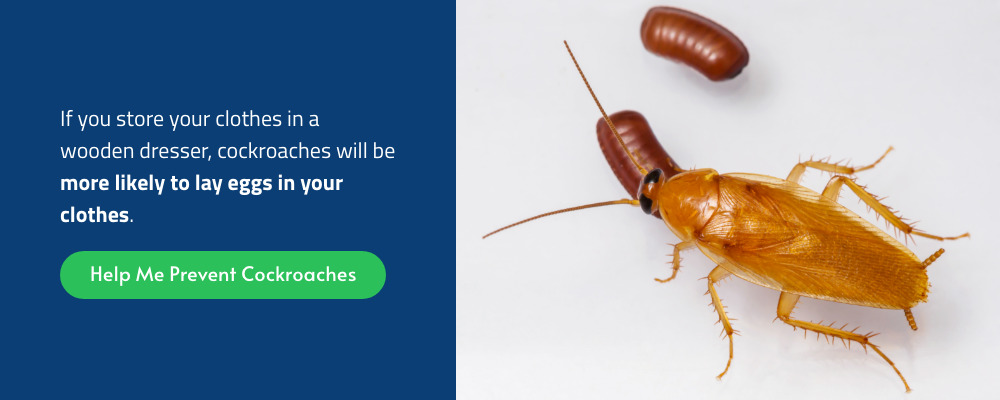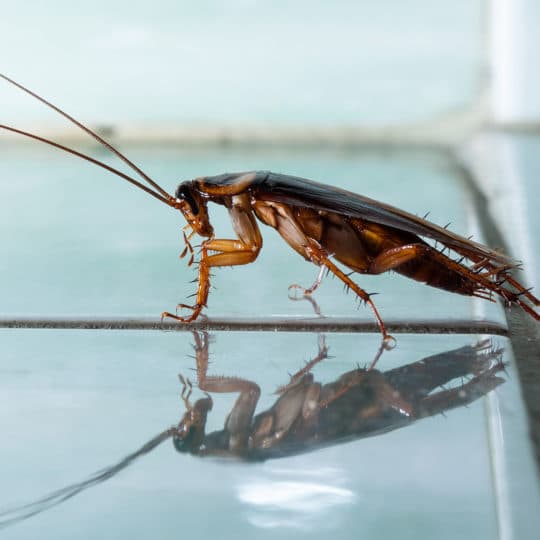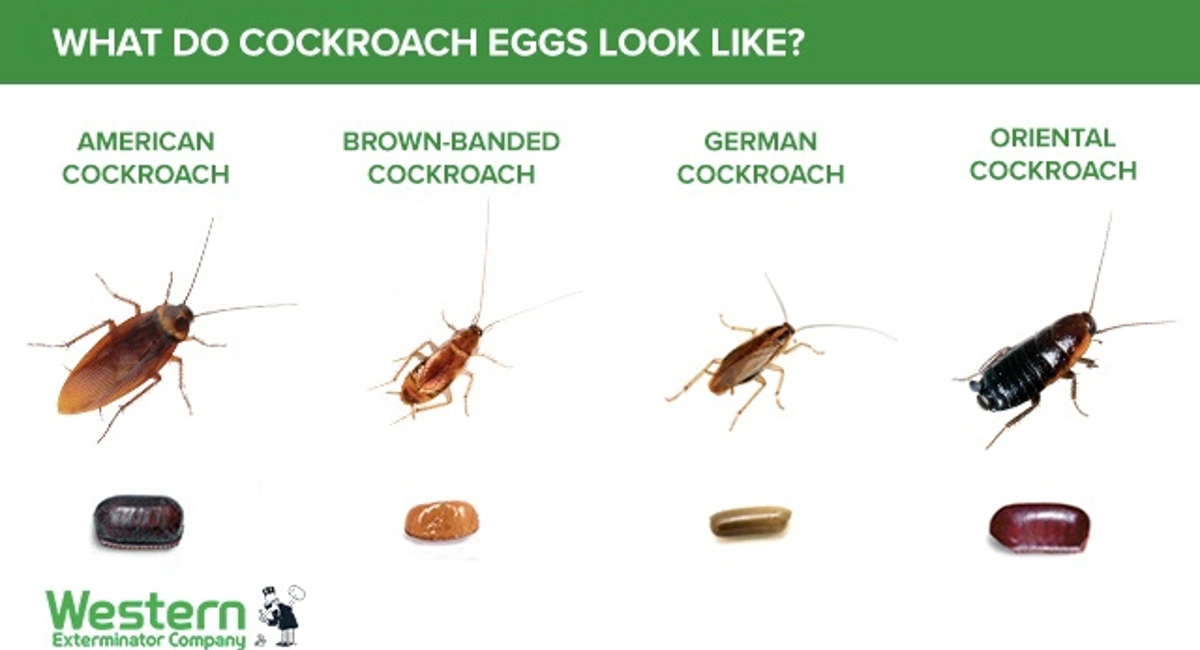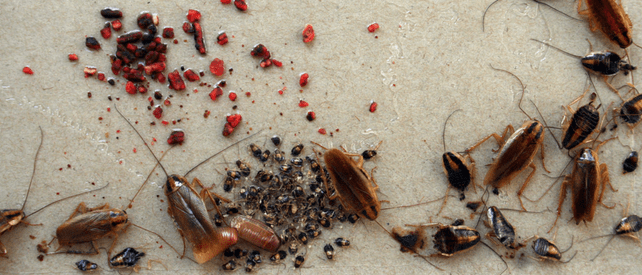Cockroaches lay their eggs in dark, secluded places near a food source. This means that they can be found hiding behind refrigerators, under sinks, or in other tight spaces.
The female cockroach produces an egg case, called an ootheca, which can contain up to 50 eggs. These egg cases are often brown or dark in color and can easily blend in with their surroundings, making them difficult to spot.
Cockroach infestations can be a major problem in homes and businesses, as they can quickly multiply and spread. Knowing where these pests lay their eggs can help in identifying and eliminating an infestation. We will discuss in detail where cockroaches lay their eggs and how to prevent them from doing so.
Understanding Cockroach Reproduction
Cockroaches lay their eggs in dark and secluded places near their food source, such as behind the refrigerator or under the sink. They prefer areas that are warm, dark, and rarely disturbed, making them difficult to find.
Understanding Cockroach Reproduction:Cockroaches are one of the most adaptable and resilient pests, and their reproduction is one of the key reasons for their success. Cockroaches lay eggs, which hatch into nymphs and grow into adults. In this section, we will explore the life cycle of a cockroach, the role of eggs in their reproduction, and the factors influencing their egg-laying behavior.The life cycle of a cockroach:The life cycle of a cockroach begins with an egg, which is laid by the female. The egg then hatches into a nymph, which looks like a smaller version of an adult cockroach but lacks wings. The nymph undergoes several molts, shedding its exoskeleton and growing larger with each molt. Finally, the nymph reaches adulthood, where it gains wings and becomes sexually mature.The role of eggs in cockroach reproduction:Eggs play a crucial role in the reproduction of cockroaches. The female cockroach lays eggs in a protective case called an ootheca. The ootheca contains multiple eggs, and the female can lay several oothecae during her lifetime. Once the eggs hatch, the nymphs emerge from the ootheca and begin their life cycle.Factors influencing egg-laying behavior:The egg-laying behavior of cockroaches is influenced by several factors, including temperature, humidity, and availability of food and water. Cockroaches prefer to lay their eggs in dark, secluded places, where they are protected from predators and environmental stressors. They may lay their eggs in crevices, cracks, or other protected areas, such as behind appliances or under furniture. Understanding the factors that influence their egg-laying behavior can help in preventing and controlling their infestation.In conclusion, understanding the reproduction of cockroaches, including their life cycle, the role of eggs, and the factors influencing their egg-laying behavior, is crucial in preventing and controlling their infestation. By implementing preventive measures, such as maintaining cleanliness, sealing cracks and crevices, and reducing moisture, we can effectively control their population and keep our homes free from these unwanted pests.
Credit: pestech.com
Common Places To Find Cockroach Eggs
Cockroaches lay eggs in dark and secluded areas, often near food sources. You may find them behind the refrigerator, under the sink, or in tight spaces. They also nest in cabinets, drawers, and pantries, and can even lay eggs in clothes stored in dark and odor-absorbing places.
Common Places to Find Cockroach EggsCockroaches are known for their ability to adapt and survive in almost any environment. Unfortunately, this means they can quickly infest a home, especially if they are laying eggs. Cockroach eggs are small, oval-shaped, and typically brown or black in color. Since cockroaches prefer dark and secluded areas, it can be challenging to locate their eggs. However, there are some common places to find cockroach eggs that you can check to prevent an infestation from taking hold.Dark and Secluded AreasCockroaches are attracted to dark and secluded areas, making them the perfect spot to lay their eggs. Common places to check for cockroach eggs include:– Behind and under appliances: refrigerators, stoves, and dishwashers – Inside cabinets and drawers: especially those in the kitchen and bathroom – In cracks and crevices: along baseboards, behind wallpaper, and in between floorboards – In storage areas: boxes, bags, and other cluttered spacesNear Food SourcesSince cockroaches need a food source to survive, they will typically lay their eggs near areas where food is readily available. This includes:– Pantries and cupboards: check for eggs near open food containers – Trash cans: cockroaches may lay eggs in or around trash cans – Pet food areas: if you have pets, check their food bowls and the surrounding area for eggsSpecific Areas in the Home to CheckTo prevent a cockroach infestation from taking hold, it’s essential to check specific areas of your home where they are known to lay eggs. These areas include:– The bathroom: cockroaches are attracted to moisture, making the bathroom an ideal spot for them to lay their eggs – The kitchen: cockroaches are drawn to food and warmth, making the kitchen a prime spot for them to lay their eggs – The bedroom: cockroaches can hide in clothing, bedding, and other fabrics, making the bedroom an attractive location for them to lay their eggsBy checking these common places to find cockroach eggs, you can prevent an infestation from taking hold in your home. If you do find eggs, it’s essential to take immediate action to eliminate them before they hatch and create a more significant problem.Identifying Cockroach Eggs
Cockroaches typically lay their eggs in dark and secluded areas, close to a food source. Common spots include behind refrigerators, under sinks, and in tight spaces. Roach eggs are often found in crevices and protected areas and can be visible.
Regular inspection and cleaning of these areas can help prevent infestations.
Identifying Cockroach EggsCockroaches are a common household pest that can cause a lot of trouble. These pests can lay eggs in almost any place in your home, which makes identifying them a crucial step in controlling their population. If you’re struggling with a cockroach infestation, it’s essential to identify where they’re laying their eggs so that you can eliminate them effectively. In this article, we’ll discuss how to identify cockroach eggs and differentiate them from other pests.Physical Appearance of Cockroach EggsCockroach eggs are usually oval-shaped, with a slightly curved end and a flattened side. They’re about the size of a grain of rice and are often clustered together in groups. Cockroach eggs are covered in a protective casing called an ootheca, which is brown or reddish-brown in color. The ootheca is often mistaken for a cockroach itself, but it’s just a casing that protects the eggs.Size and Color VariationsDifferent species of cockroaches lay eggs of different sizes and colors. For example, German cockroach eggs are smaller and darker than American cockroach eggs. If you’re unsure which type of cockroach you’re dealing with, it’s essential to get a professional pest control service to help you identify and eliminate the infestation.Differentiating Cockroach Eggs from Other PestsCockroach eggs are often mistaken for other pests’ eggs, such as bed bugs or carpet beetles. However, there are some key differences that can help you differentiate between them. Bed bug eggs are smaller and white, while carpet beetle eggs are oval-shaped and white or cream-colored. Cockroach eggs have a distinct ootheca casing that surrounds them, which is unique to this pest.In conclusion, identifying cockroach eggs is crucial in controlling an infestation. By knowing what to look for and differentiating them from other pests, you can effectively eliminate the infestation and prevent future ones. If you’re unsure about how to identify cockroach eggs or need help eliminating an infestation, it’s essential to contact a professional pest control service for assistance.Preventing Cockroach Egg Infestations
Cockroaches typically lay their eggs in dark, secluded areas near a food source, such as behind refrigerators or under sinks. It’s important to check these hidden spaces to prevent cockroach egg infestations.
Preventing Cockroach Egg InfestationsCockroaches are known to lay eggs in dark, secluded areas, making it difficult to detect and eradicate them. Thus, it is crucial to take preventive measures to avoid cockroach egg infestations. Here are some effective ways to prevent cockroach egg infestations.Maintaining cleanliness and hygieneCockroaches thrive in dirty and cluttered environments, so it is essential to maintain cleanliness and hygiene in your home. Regularly clean and vacuum your house, especially areas where food is stored or prepared. Ensure that there are no crumbs or spills on the floor or countertops. Dispose of garbage regularly and keep the trash cans covered.Sealing entry pointsCockroaches can enter your home through small cracks and crevices. Sealing entry points such as gaps around pipes, doors, and windows can prevent cockroaches from entering your home. Use caulk or weather-stripping to seal the gaps. Additionally, repair any leaky pipes and faucets as cockroaches are attracted to moisture.Removing potential nesting sitesCockroaches prefer to lay their eggs in warm, dark, and secluded areas. Thus, it is crucial to remove any potential nesting sites. Declutter your home and get rid of any unused items, cardboard boxes, or piles of paper. Store food in airtight containers and avoid leaving pet food out overnight. Clean and sanitize your kitchen appliances regularly, especially behind and under them.By following these preventive measures, you can avoid cockroach egg infestations in your home. Remember that prevention is better than cure, and it is easier to prevent cockroaches from entering your home than to eradicate them once they have infested it.Dealing With Cockroach Eggs In Clothes
Discovering cockroach eggs in your clothes can be a distressing experience. Not only can it indicate a potential infestation in your home, but it also poses a hygiene concern. Understanding why cockroaches lay eggs in clothes and knowing how to eliminate them is crucial in maintaining a pest-free environment.
Why Cockroaches Lay Eggs In Clothes
Cockroaches have a knack for finding the most suitable spots to lay their eggs. Clothes provide an ideal environment for cockroach eggs due to several factors:
- Odor absorption: Cockroaches prefer nesting in areas that can absorb their strong odor. Clothes made of materials like paper, cardboard, or wood are particularly attractive to them.
- Darkness: Cockroaches are nocturnal creatures, and they tend to seek out dark and secluded spaces for egg-laying. Clothes, especially when stored in drawers or closets, offer the perfect hiding place.
- Protection: Cockroaches instinctively look for areas where their eggs will be safe from disturbances. Clothes provide a protective barrier, making it harder for predators or cleaning activities to reach the eggs.
Methods To Eliminate Eggs From Clothes
When dealing with cockroach eggs in clothes, it is essential to act promptly to prevent further infestation. Here are some effective methods to eliminate cockroach eggs from clothes:
- Washing: Laundering the infested clothes using hot water and detergent is the most straightforward and effective way to eliminate cockroach eggs. The high temperature and cleaning agents will kill the eggs and remove any potential allergens or bacteria.
- Dry cleaning: If the clothes are delicate or require special care, dry cleaning can be a viable option. Inform the dry cleaner about the presence of cockroach eggs so they can take appropriate measures to ensure thorough cleaning.
- Freezing: For items that cannot be washed or dry cleaned, freezing can be an alternative method. Place the infested clothes in a sealed plastic bag and freeze them for at least 48 hours. The extreme cold temperatures will kill the eggs.
Preventive Measures For Clothes Infestations
Prevention is always better than dealing with an infestation. To safeguard your clothes from cockroach eggs, consider implementing these preventive measures:
- Storage practices: Store clothes in sealed plastic containers or bags to minimize the risk of cockroach infestation. Avoid using wooden dressers or cardboard boxes for clothing storage.
- Cleanliness: Regularly clean your closets, drawers, and laundry areas to eliminate any potential hiding spots for cockroaches. Vacuuming and wiping down surfaces can help remove food particles and prevent attracting cockroaches.
- Sealing entry points: Seal any cracks or openings in walls, windows, and doors to prevent cockroaches from entering your home in the first place. Pay attention to gaps in the laundry room or areas where pipes enter the house.
- Professional pest control: If you suspect a cockroach infestation, it is best to seek the assistance of a professional pest control service. They can identify the source of the infestation and implement targeted treatments to eradicate the problem.
By understanding why cockroaches are attracted to clothes, taking appropriate measures to eliminate eggs, and implementing preventive strategies, you can minimize the risk of cockroach infestations in your wardrobe and maintain a clean and hygienic living environment.
Unusual Places Cockroaches Lay Eggs
Cockroaches, known for their resilience and adaptability, are notorious for laying eggs in unexpected places. Understanding the unusual locations where these pests deposit their eggs is crucial for effective infestation control.
Weird And Unexpected Locations
Cockroaches are known to lay eggs in unusual and unexpected locations, such as inside electronic appliances, behind wallpaper, and even within seams of furniture. These obscure spots provide the necessary darkness and protection for the eggs to develop undisturbed.
The Role Of Ootheca In Egg Deposition
The ootheca, a protective casing produced by the female cockroach, plays a significant role in egg deposition. This unique structure safeguards the eggs from predators and environmental hazards, allowing them to hatch under favorable conditions.
Implications For Infestation Control
Understanding the unusual locations where cockroaches lay eggs has implications for infestation control. Inspecting and sealing off these unexpected areas is essential for effective pest management, preventing the development of new generations and curbing infestation spread.
The Dangers Of Cockroach Egg Infestations
Cockroach egg infestations can pose serious health risks and dangers to your home. Understanding the potential hazards of these infestations is crucial in taking the necessary steps to eradicate and prevent them from spreading further.
Health Risks Associated With Cockroach Eggs
Cockroach eggs can lead to various health issues, particularly for individuals with respiratory conditions and allergies. Their presence can exacerbate asthma and trigger allergic reactions in sensitive individuals.
Allergies And Respiratory Issues
For individuals prone to allergies and respiratory issues, cockroach eggs can worsen their symptoms, leading to coughing, wheezing, and difficulty breathing. Children and the elderly are particularly vulnerable to these adverse effects.
Spread Of Bacteria And Diseases
Cockroaches are known carriers of bacteria and pathogens, and their eggs can further contribute to the spread of diseases. The presence of cockroach eggs in your home increases the risk of contamination, potentially leading to foodborne illnesses and other infections.

Credit: www.extermpro.com
Effective Methods For Cockroach Egg Removal
When it comes to dealing with a cockroach infestation, it is important to not only eliminate the adult roaches but also target their eggs. Cockroaches are notorious for laying eggs in dark and secluded areas, making it crucial to identify and remove these eggs to prevent future infestations. In this article, we will explore effective methods for cockroach egg removal, including professional pest control services, DIY methods, and follow-up prevention strategies.
Professional Pest Control Services
If you are dealing with a severe cockroach infestation or if you want a guaranteed solution, it is highly recommended to seek the assistance of professional pest control services. These experts have the knowledge, experience, and tools to effectively locate and eliminate cockroach eggs from your home. They will conduct a thorough inspection of your property, identifying potential egg-laying sites and implementing targeted treatments to eradicate both adult roaches and their eggs.
Diy Methods For Removing Cockroach Eggs
If you prefer to tackle the cockroach egg removal process yourself, there are several DIY methods that you can try. However, it is important to note that these methods may not be as effective as professional treatments, especially for severe infestations. Nevertheless, here are some DIY methods that you can consider:
- Regular cleaning: Cockroaches are attracted to unclean and cluttered areas, so keeping your home clean and tidy can discourage them from laying eggs. Regularly vacuuming, sweeping, and mopping your floors, as well as wiping down surfaces, can help prevent egg-laying.
- Sealing cracks and crevices: Cockroaches often hide and lay eggs in cracks and crevices around your home. By sealing these entry points with caulk or weatherstripping, you can prevent them from accessing these areas and laying eggs.
- Using cockroach baits and traps: Cockroach baits and traps can be effective in attracting and killing adult roaches, which in turn reduces the chances of them laying eggs. Place these baits and traps in areas where roaches are commonly seen or suspected to lay eggs.
- Applying natural repellents: Some natural substances, such as peppermint oil, bay leaves, and catnip, are said to repel cockroaches. Spraying these repellents in areas where roaches might lay eggs can help deter them.
Follow-up Prevention Strategies
After successfully removing cockroach eggs from your home, it is essential to implement follow-up prevention strategies to ensure that they do not return. Here are some preventive measures you can take:
- Keep your home clean: Regularly clean your home, especially areas where food is prepared and stored. Cockroaches are attracted to food sources, so minimizing their access to food can discourage them from returning.
- Eliminate moisture: Cockroaches thrive in humid environments, so reducing moisture levels in your home can make it less hospitable for them. Fix any leaks, use dehumidifiers if necessary, and ensure proper ventilation in areas prone to moisture buildup.
- Seal entry points: Close off any potential entry points for cockroaches by sealing cracks, gaps, and holes in your home’s exterior. This will make it harder for them to gain access and lay eggs.
- Store food properly: Keep food in sealed containers and avoid leaving food out overnight. This not only prevents cockroaches from accessing a food source but also reduces the chances of them laying eggs near it.
By following these effective methods for cockroach egg removal and implementing preventive measures, you can significantly reduce the chances of a reinfestation and enjoy a cockroach-free home.

Credit: www.westernexterminator.com
Frequently Asked Questions
How To Find Cockroach Eggs?
Cockroach eggs are typically found in dark and secluded areas near a food source. Check behind the refrigerator, under the sink, and in tight spaces. Roaches also nest in cabinets, kitchen drawers, and pantries. They may even lay eggs in clothes stored in wooden dressers.
Look for egg cases called oothecae.
How Do You Find Where Roaches Are Nesting?
To find where roaches are nesting, check dark and enclosed areas like cabinets, kitchen drawers, and pantries. Roaches like to lay their eggs in secluded places near the food source, so they may be hiding behind your refrigerator or stove.
They prefer warm, dark, and undisturbed areas. The eggs are deposited in crevices and other protected areas, making them difficult to spot.
Do Roaches Lay Eggs In Clothes?
Yes, cockroaches can lay eggs in clothes. They prefer nesting in areas that absorb their strong odor, such as paper, cardboard, or wood. If you store your clothes in a wooden dresser, cockroaches are more likely to lay eggs in your clothes, as they are attracted to secluded and dark places.
Conclusion
Understanding where cockroaches lay their eggs is crucial for effective pest control. By identifying their nesting spots, such as dark and secluded areas, we can target these locations for eradication. Knowing how to find and recognize cockroach eggs is key to preventing infestations and keeping our homes free from these pests.
Related posts:

I’m MD Tanvir, and I bring years of expertise gained from working closely with pest control companies to the forefront. My journey in the industry has inspired me to launch Bug Battler, a platform aimed at equipping people with the know-how to combat pests autonomously. Through Bug Battler, I aim to empower individuals with practical insights to tackle pest infestations effectively.

